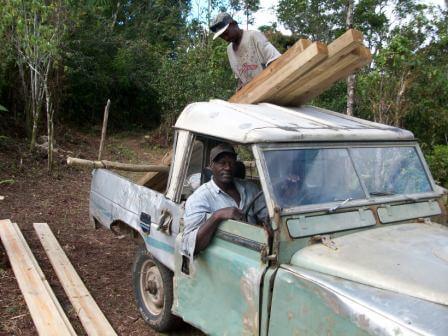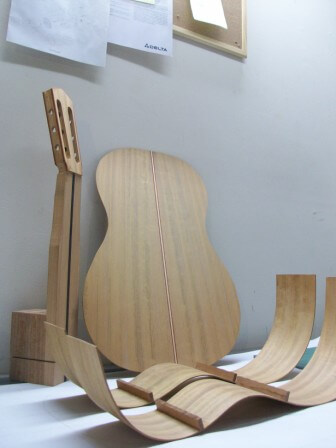Classical Guitar from Jamaica?

Well, I deliver it in bites and chunks here and there. Different things bring back different memories. What does this have to do about handmade classical guitars? First, I never quit dreaming about building guitars the whole time I was in Jamaica. Being an outdoorsy person, I spent ample time in the backcountry, rumaging around in places where I probably shouldn't have been. The first two weeks I was in the country, my Jamaican counterpart guided me into the bush that would be the future focus of a trail project that we worked on for the next two years.
On that trail, an old Maroon path that connected the towns of Accompong with Quick Step, there was an old dead tree lying smack dab in the way. My couterpart refered to this tree as "Mosquito Wood" (Mosquitoxylum Jamaicence) - the local vernacular for the hardest and heaviest wood in the Jamaican Cockpit Country. It looked quite rotten on the outside, but if you took your machete and chipped away a bit then it revealed a bright yellow heartwood. The old Jamaican farmers use this wood for fence posts because it never rots. This particular log was known by the oldest men in the town who said that they used to run down that trail when they were "pickni" (children) and it looked rotten back then too (we're talking about 70 years).
The first time I stumbled by that tree I had immediately thought of what kind of guitar that it would make, and the idea quickly entered my mind that I would carry a piece back and make a guitar with it. When my service was finished and I only had two weeks left on the island, I hired Barry (the guy in the 1960's Land Rover above) to go out in the bush with me and cut some boards from this log. That's what Barry did anyway. Every day he was out in the bush cutting trees and making boards. He didn't have anything fancy, just a STIHL chainsaw that he used to cut down the trees and slab cut boards. Some people have fancy attachments they place on their saw to keep it from wandering, but Barry just did it free hand.
I was a little worried at first, because I knew I would have to teach him to cut it on the quarter, but Barry sliced into the wood without any hesitation. I had started to think that the day couldn't possibly be going any better, and then, Barry's saw completely died. In about 5 minutes the whole saw was lying in pieces on the jungle floor. Tiny little screws and springs that I could even lose on a concrete floor were sitting on top a litter of twigs, leaves and moss. I was about to throw in the towel and claim defeat when Barry stood up, yanked the choke, and blew a fresh batch of good exhaust in my face. The saw sounded like new. As my Jamaican friend said standing beside me, "Barry knuow im saw".
Transporting the resulting four foot long, heavy chunk of a log back to the US from a place that’s known for hallucinogenic raw materials warrants some respect. I began playing different scenerios with customs officials in my head.
"Where are you coming from today sir?" - "Jamaica" - "What's that heavy obj... ...I am going to have to ask you to come with me sir."
Thankfully I never had to take the log through customs. When I reached back to the US it never showed up in the baggage claim. Of course, I thought it was lost. So a few hours later when I was waiting for my luggage at the Nashville airport, I was pretty surprised to see it shoot through the conveyor curtain.
Oddly enough - my other luggage was lost.
Pictures of the Jamaican Guitar

